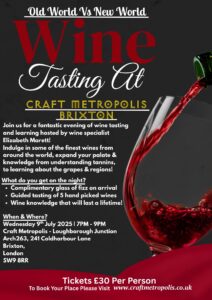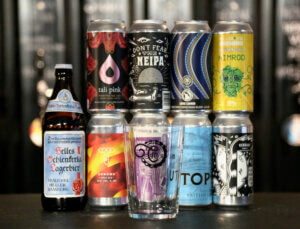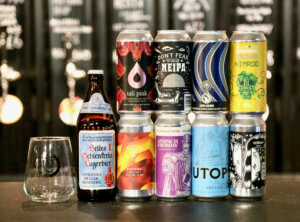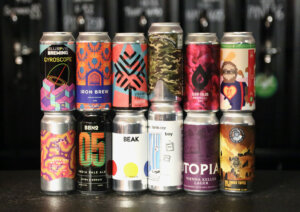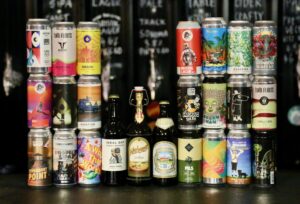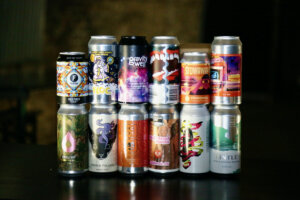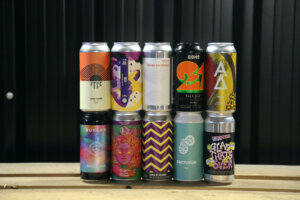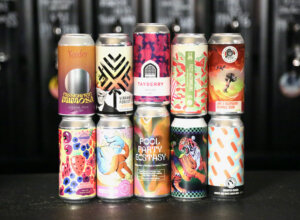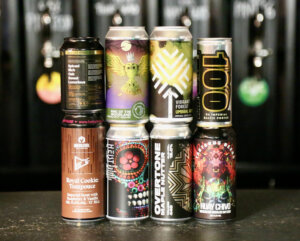Traditionally, the World Beer Awards are unlikely to make Rob Fink nervous.
As the founder of the internationally acclaimed Big Drop Brewing, he’s been interviewed across major US TV networks. He’s negotiated contracts with multinationals. And his brewery’s beers have picked up multiple World Beer Awards in the past.
This year’s event, however, is different.
Because this year, if Big Drop’s Galactic Milk Stout picks up another gong, it will become the most decorated beer in history. Ahead of all others. Unrivalled worldwide.
That’s not bad going for a beer that’s alcohol free.
Just seven years before the 2021 World Beer Awards, Rob Fink was a City lawyer in a bind.
He’d recently become a father. And in an effort to be a ‘21st century dad’, he’d decided to pause his drinking for six months. His problem, however, was his job: it entailed new business development over long, boozy lunches in London’s public houses.
Historically, Rob had always been a beer drinker. He’d loved beer in its ‘macro’ form and then, later, he’d loved craft beer (he’d eventually go on to declare Goose Island’s IPA one of his very favourites).
So when, following fatherhood, Rob returned to pubs with clients, he began asking bartenders for non-alcoholic beer. Or non-alcoholic lager, at least. It was always lager.
Rob drank one. Then another. He liaised with his contacts and, in the same way one might begin to think a little differently when drinking the hard stuff, Rob began to wonder…
Why was the only non-alcoholic beer ever on offer lager?
And why did non-alcoholic lager taste so… distinct?
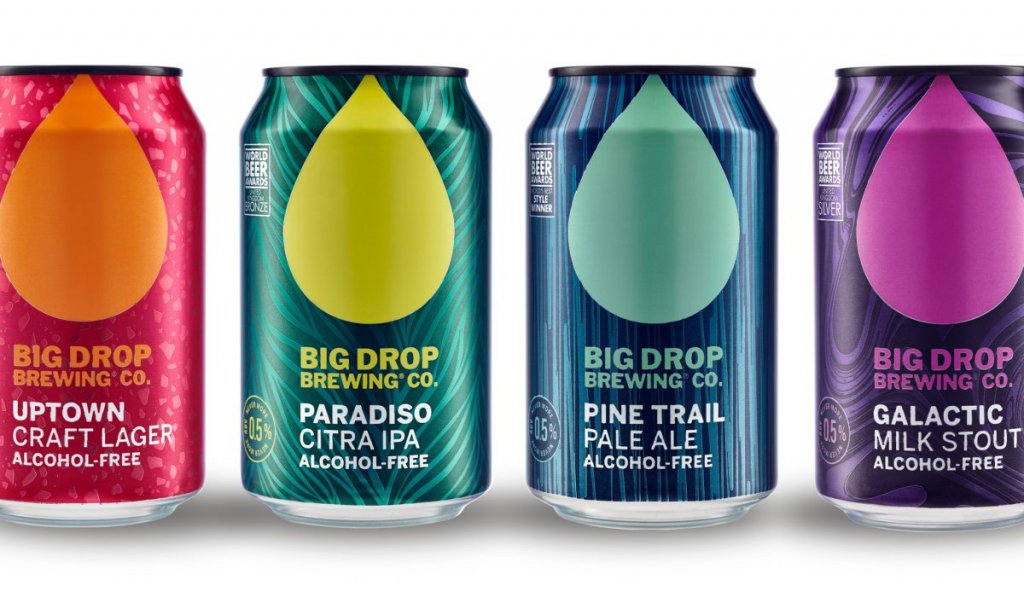
Non-alcoholic beer’s history dates back to medieval times. ‘Small beer’, as it was then known, was usually made from the remnants of beer proper, and peasants would drink it as a healthy alternative to (often contaminated) water.
It wasn’t until much later, however, that non-alcoholic beer became commercialised. US Prohibition set the wheels turning. Unable to sell full strength beer (legally, at least), brewers began making and selling non-alcoholic beers.
This was as far back as 1920, using somewhat primitive techniques. And when Rob Fink began ordering his non-alcoholic pints in 2014, things hadn’t advanced all that much at all.
It wasn’t long after Rob’s early daliences with non-alcoholic lagers that his emails began. In rare moments outside of work and parenting, Rob started to email brewing consultants.
Rob had questions.
Why, for example, hadn’t anyone brewed a non-alcoholic stout in the past? Or, for that matter, a non-alcoholic lager with more flavour?
Rob knew almost nothing about brewing. But he couldn’t resist tugging the unwinding thread.
He received replies – some pleasant, some not. Before long, he understood the crux of the issue.
When prohibition-era brewers first began brewing non-alcoholic beers, they had no interest in reinventing the wheel. As far as they saw it, they brewed good beer. So their task was to remove the alcohol from the good beer they had. That left them with two options.
The first was boiling. As ethanol boils at a lower temperature than water, to remove alcohol from beer, brewers can – and do – boil good beer. The trouble is, when you boil the alcohol from beer, much of the beer’s flavours evaporate too.
As an alternative to boiling, some brewers used reverse osmosis. This was perhaps a minor improvement. But it turns out when you force a beer’s alcohol and water through a semipermeable membrane then dilute the leftovers, the non-alcoholic ‘beer’ you end up with isn’t particularly pleasant.
And yet this was what Rob was drinking, and what many brewers continue to offer today. Beer that’s been denatured. Defaced. Once-good beer that’s been stripped of its alcohol and, in the process, much of its flavour.
It was little wonder few had attempted to market a non-alcoholic stout.
When Rob Fink set up Big Drop Brewing in 2016, the beer world was awash with innovation. The ‘craft revolution’ was underway, and Rob wanted to join it.
Rob wanted to make great beers. Great beers that just, as Rob puts it, ‘happen to be alcohol free’. Today Rob’s vision is reflected through Big Drop’s brewing process.
Unlike many who brew non-alcoholic beers, Big Drop never brew a beer then remove its alcohol. Instead, they simply brew 0.5% ABV beers (meeting the UK’s definition of alcohol free).
Big Drop aren’t in a hurry to reveal exactly how they achieve this, but Rob is willing to disclose it involves a ‘lazy’ yeast that, to the delight of Idlers everywhere, can’t really be bothered to convert sugar to alcohol. It’s this yeast – along with other wizardry – that permits Big Drop to brew fully fermented beers that just so happen to be alcohol free.
This January, much of the country will be cutting back on booze as part of Dry January. Others will have already gone Sober for October. Such campaigns, along with trends towards healthier lifestyles, go some way to explaining rapidly increasing sales of boozeless bevs.
But according to the analyst IWSR, the current non-alcoholic drinks surge is almost entirely explained by non-alcoholic beer sales alone, thanks to brewers ‘investing in new brewing techniques and product innovation’.
Since 2016, Big Drop’s unassuming, bespectacled and eminently likeable Rob Fink has handed beer fans further choice.
Big Drop’s innovative brewing techniques have given us alcohol-free pales, IPAs, stouts and porters. Big Drop have even released alcohol-free sours.
Above all though, innovative brewing has given Rob – who has long since left his previous life behind – what he wanted to begin with: great tasting beer… that just so happens to be alcohol free.
By the time 2021’s World Beer Awards rolled around, Big Drop’s Galactic Milk Stout was 5 years old. It had been perfected. And it was just one award away from becoming the most decorated beer in history.
There was trepidation and there was apprehension. But eventually, when the judges named Galactic Milk Stout the World’s Best Low Alcohol Beer, it was almost routine. This, after all, is a beer that’s won awards when competing outside of its low alcohol ‘category’ in the past.
‘We recently won Best Beer in Show at the Stockholm Beer & Whisky Show’, Rob points out. ‘Quite simply, these beers can be as good as full-strength beers.’ He’s right. Make no mistake, should any idle beer lover wish to cut back on booze at any point, it’s now possible to do so – without resorting to substandard swill.

1. Big Drop Brewing Co. – Galactic Milk Stout
The beer that revitalised AF beers. Think indulgent honeycomb dipped in chocolate. The current World’s Best Low Alcohol beer.
2. Big Drop – Pine Trail Pale
Big floral aromas and notes of bright citrus on the palate, which fade into a reassuringly familiar bitter finish.
3. Hammerton – Crunch Alcohol Free Peanut Butter Milk Stout
It took Hammerton no fewer than 37 experiments to perfect Crunch, and even further tinkering to squeeze the perfect ratio of Peanut Butter, Lactose, and Biscuit into AF form. Silky-smooth and sweet. A Snickers in a can.
4. Lowtide Brewing Co. – Brune-DMC
Lowtide’s take on a traditional Belgian abbey beer is dark, sweet and fruity. A must for those into European ales.
5. Good Karma – Happy Pils
A classic alcohol-free pilsner with light malts and bitter hops balancing perfectly for maximum refreshment. No flavour compromise.
Oli Meade owns and runs Craft Metropolis, an online beer shop and taproom that stocks low- and no-alcohol beers, as well as their full strength counterparts. craftmetropolis.co.uk.
In craft beer circles, every year that unfolds eventually becomes the year of something or other. Certain yeasts, for example. Or certain varieties of hops. More often than not, certain beer styles take the annual ‘year of’ crown – like back in 2018, when everyone seemed excited about brut IPA. I’ve reported before that every year seems poised to become ‘lager year’ (and every year, it never is). This year, there’s a clear title winner already: 2020 is the year of the triple IPA (TIPA), a beer style characterised by an intense hop profile and an ABV that regularly climbs beyond 10%. This year, everyone’s been brewing them. Who wore it best, you ask? Here are three of my personal favourites.
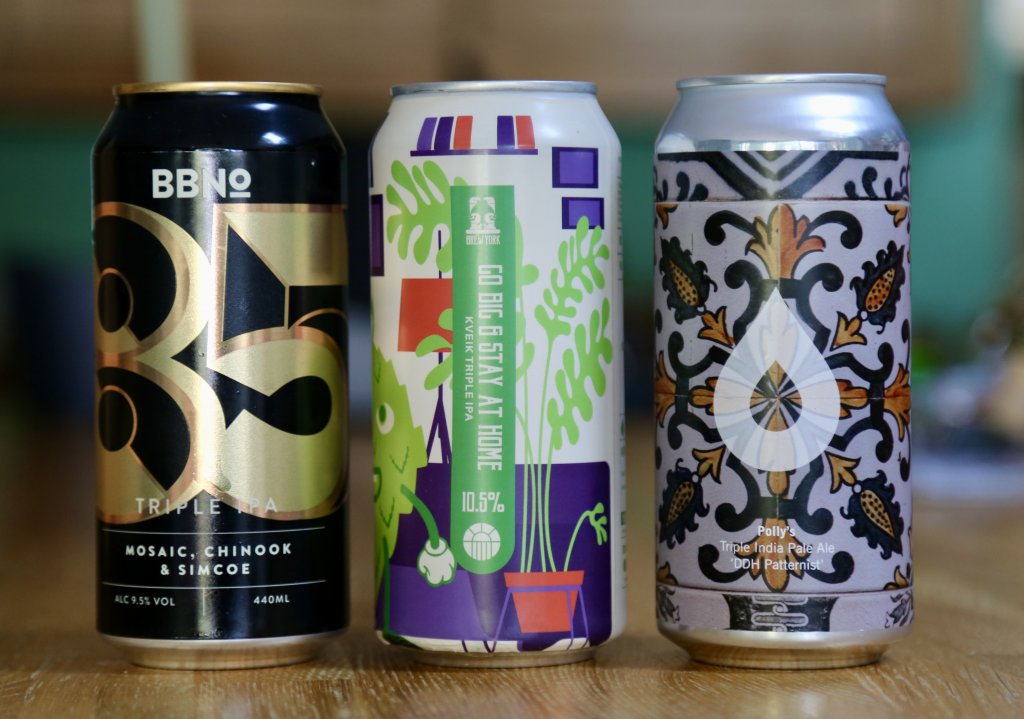
It’s hard to not start with the easiest drinker in the category. Let’s be honest, when you’re dealing with beers that regularly come with double-digit ABVs – especially when they aren’t fireside sippers like imperial stouts – then ‘easy-drinking’ is quite a sought-after quality. Brew by Numbers have always delivered great beers with higher ABVs than the corresponding flavour profiles suggest. Anyone that’s ever tried one of their 55 Double IPA series will almost certainly agree. Would their new 85 Triple IPA follow suit? And what particular nectar variety might it bring us?
Sweet fruit juice is the answer! The current version in the BBNo’s 85 series is a beer that pours very hazy and delivers wave upon wave of ripe (and overripe) stone fruit like peach and mango from the trio of hops BBNo’s brewers use. What really sets the beer apart is the smoothness from the oats the BBNo team add to the brew’s malt bill. It’s a quality that dials down the bitterness (that’s just about lurking) and makes 85 Triple IPA insanely drinkable. It’s complex, juicy and scarily easy to drink! From DIPAs to TIPAs, I’m not sure there’s a UK brewery that consistently delivers high-ABV, hoppy beers better than Brew by Numbers.
With Brew York, you always know they’ll take on a challenge. You can also be pretty certain they’ll serve up on-trend brews, so it was hardly a surprise to see them brewing a triple IPA as soon as it looked like it may be flavour of the season. Brew York is the brewery that brought us delights like Tonkoko – a coconut and tonka bean stout – and Extra Brownie Pints – an absolute chocolate slab of an imperial monster. To put it mildly, the brewery has the darker stuff nailed. But lighter stuff always receives more scrutiny; it’s tough to hide suspect subtleties in lighter beers. With their new triple, however, Brew York have not only cracked the of-the-moment style but have gone and scored bonus points by using of-the-moment yeast kveik while doing so. Brew York’s TIPA couldn’t be more on-trend if it tried (which, thinking about it, it probably did). Go Big & Stay at Home uses the famous Norwegian yeast strain that imparts an added earthiness and spice to the beer that could be overpowering – but isn’t – and leaves Go Big & Stay at Home slightly drier than other beers of its style. The tweak balances brilliantly the booziness of the TIPA and compliments the slight hop-burn you get from the 10.5% ABV. It’s certainly a combination that works. If you’re looking for a beer that throws together everything new that 2020 brewing has to offer, then this is pretty much it… all in one glass.
Polly’s doesn’t really brew a bad beer. The team also knows plenty about getting the best out of the hops they use. Still, until the latter part of 2020, Polly’s had been serving up soupy IPAs and pale ales only. Obviously keen to join this year’s hop-race with a triple of their own, Polly’s have now brewed not one but two TIPAs in the space of a few months. The result has been nothing short of phenomenal, with a lot of people calling their fist triple – Spur – the beer of the year. Spurred on by this acclaim (sorry), the team set about brewing their sophomore TIPA to quell the calls of those clamouring for more. The result is Patternist. Just like Spur, Patternist has a supercharged hop bill responsible for the bucketloads of flavour on show here. Apparently, Polly’s poured over 60kg of El Dorado and Simcoe hops into Patternist (I’m told that’s a LOT for one Polly’s brew). The hefty hop helping makes this beer – despite its 10% booze levels – pure unadulterated juice! There’s next to zero bitterness in the body and the hit on the tongue is straight up mango, passionfruit and papaya. It’s a joy to behold, and it may be my personal favourite of the three.
Beers of the TIPA strength, of course, have long been the drink of choice for certain park bench gentlemen. But natural brewing evolution has escorted us to a wonderful place, where 10% beers are no longer something to be endured rather than enjoyed while wincing in Belgian-beer-house bravado contests.
Stand alone, hefty TIPAs are genuine beer of the year contenders and any brewery worth their salt should be adding one to their catalogue – assuming they’re up to the challenge of brewing something drinkable despite such high alcohol content. Enjoy TIPAs responsibly. And whatever you do if you sample them, don’t go pouring these three back to back to test my tasting notes – it might be the end of you!
Craft Metropolis is an online beer shop and taproom stocking Triple IPAs, amongst brews of a more sessionable strength!
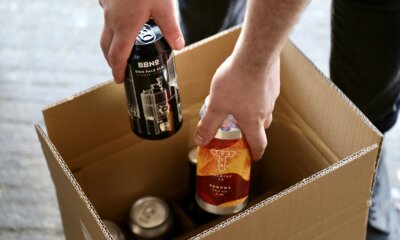 Step 1
Step 1
We trawl the globe tasting great beer
